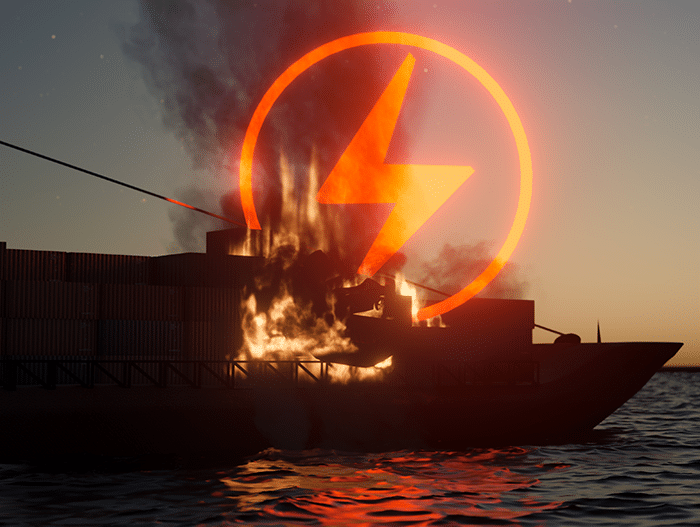
Op-Ed: Sailing into the future with non-toxic & non-flammable batteries
Written by
According to Maritime Battery Forum, as of 2023, there are 439 ships in operation with batteries, and 167 are under construction. (Credit: Shutterstock)
Shipping needs an affordable and safe alternative to lithium-ion batteries
By Mukesh Chatter
Mukesh Chatter is the CEO of Alsym Energy, a technology company developing a low-cost, high-performance rechargeable battery chemistry that is free of lithium and cobalt.
The shipping industry once used clean wind power to travel around the world. But today, thanks to combustion engines, shipping contributes an estimated 1,056 million tonnes of CO2, accounting for approximately 3% of the total global anthropogenic CO2 emissions. For other pollutants, including nitrogen oxide (NOx) and sulfur oxide (SOx), approximately 15% of their release globally comes from shipping.
In response to these staggering figures, the International Maritime Organization (IMO) has created decarbonization targets to reduce the carbon impact of international shipping by at least 40% by 2030, with the hope of reaching net zero emissions by 2050—which also is the year by which the industry aims to cut its annual greenhouse gas (GHG) emissions by at least half.
Shipping goes green
Just as the automobile industry has introduced electric and hybrid vehicles to reduce reliance on fossil fuels, new technologies will also have to be implemented for the maritime industry. Future improvements could include more aquadynamic hulls that move through the water with less drag, renewable energy sources, and increased propeller efficiency. As part of this approach, onboard battery systems are tasked with playing a key role in reducing the industry’s carbon footprint and offering a cost-effective solution for powering the future of maritime shipping. According to Maritime Battery Forum, as of 2023, there are 439 ships in operation with batteries, and 167 are under construction.
Looking into the immediate future, it’s likely that we’ll see two different solutions involving battery storage. Smaller harbor vessels, ferries, OSVs, and short-sea vessels will be fully electric and charged at the port using shore power. Larger cargo ships and other transoceanic vessels will primarily use fuel cells, methanol, liquefied natural gas (LNG), or other alternative fuels for primary propulsion and rely on batteries for hotel loads, low-speed arrival/departure from port, and peak shaving applications. But any way you look at it, a significant amount of battery capacity will be needed to either partially or completely replace fossil fuels.
Lithium-Ion concerns

As exciting as an electric future would be, industry executives still have some daunting factors to consider, including cost, battery life, and safety for both crews and the environment. Lithium-ion (Li-ion) batteries are the most prominent technology in use today, but that doesn’t mean they are the best solution. Maritime industry leaders must be aware of the long list of issues and limitations that lithium-ion batteries face when considering their application.
For starters, internal shorts or high temperatures can kick off the thermal runaway process in Li-ion batteries, leading to fires. While marine battery integrators are hyper-focused on safety and incorporate extensive cooling and anti-propagation technologies into their systems, batteries are still vulnerable to physical damage and punctures, or defects from the manufacturing phase. We’ve all read reports of batteries in electric vehicles (EVs) catching fire – imagine if that vehicle was a large tanker ship in the middle of the ocean, far from help.
Unlike diesel fires, which are relatively easy to extinguish with water, lithium-ion fires’ high temperatures and toxicity make them far more difficult (and time-consuming) to extinguish. For large vessels, spraying water on a Li-ion fire has limits—383 tons of water can introduce a list to a typical Ro-Ro vessel. Additionally, lithium battery fires release thousands of liters of chemicals (up to 6,000 liters per kWh), including hydrogen, carbon monoxide, carbon dioxide, hydrogen fluoride, hydrogen cyanide, ethane, methane, droplets of organic solvents and oxides of sulfur and nitrogen into the atmosphere which would be hazardous to the air and water, as well as endangering crew members.
Aside from safety concerns, cost is a major issue. Marine-grade lithium-ion battery systems can cost as much as $600 per kWh—four times the average price of EV battery packs. That can make the cost of battery systems up to 50% of the total vessel cost. And then there’s insurance. Maritime insurance companies understand the risk of lithium-ion batteries and increase rates significantly for ships that incorporate them into propulsion systems. If lithium-ion batteries are included as cargo, rates go up even more. Recent reports suggest some insurance companies are flat-out refusing to insure lithium-ion retrofitted engines.
The lithium-ion supply chain is another point of discussion that can’t be ignored. Right now, 80% of global lithium refining capacity and 100% of spherical graphite production resides in China, and new plants in the U.S. and EU are not expected to come online for at least five years. While seagoing vessels are great candidates for electrification, marine integrators struggle to compete for supply with large automakers.
Alternative chemistries
The good news is that more battery options will soon be available as researchers and start-ups work to develop batteries with similar performance to lithium-ion but with fewer drawbacks. While some companies try to increase safety by developing solid-state lithium batteries, others are looking beyond lithium altogether. Some options, such as sodium-ion and flow batteries, are already available. However, current non-lithium technologies all have trade-offs that make them less than ideal, and none can provide the balance of energy density, size, and weight critical for shipping vessels. But other new chemistries currently under development are poised to address the needs of ship owners.
It’s safe to say the maritime industry is headed in the right direction regarding transitioning to battery-powered propulsion. The mandate to reduce international shipping’s carbon footprint is well underway with the help of emerging battery technology from providers that keep non-flammability and affordability top-of-mind. As part of this effort, lithium-ion batteries must be left behind as the maritime industry moves forward with a solution that is cheaper, safer, and more widely available.




